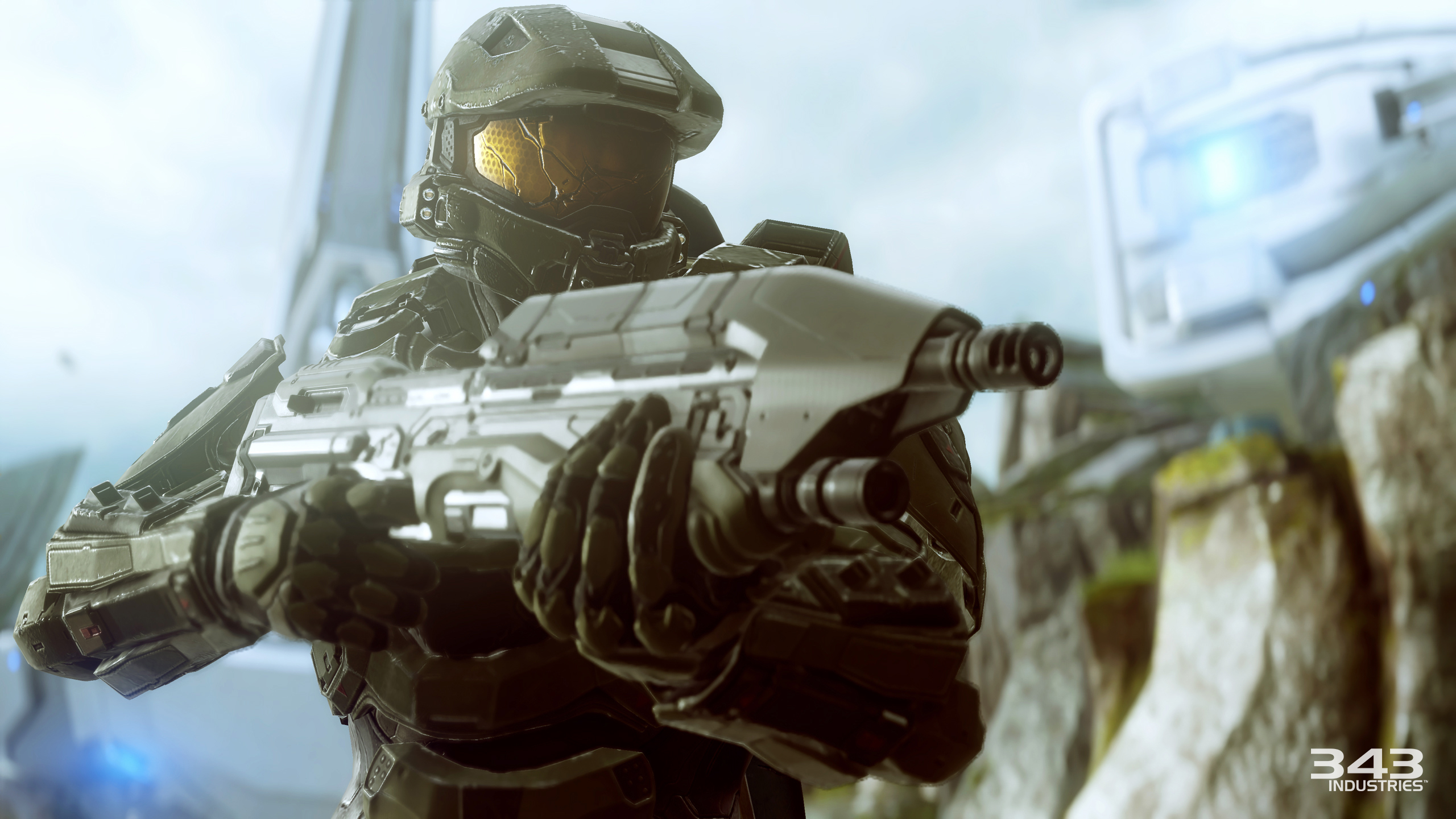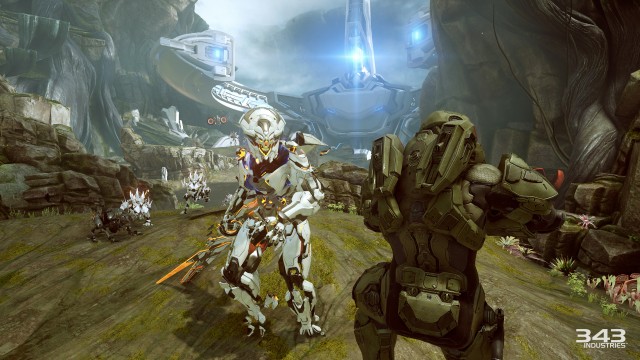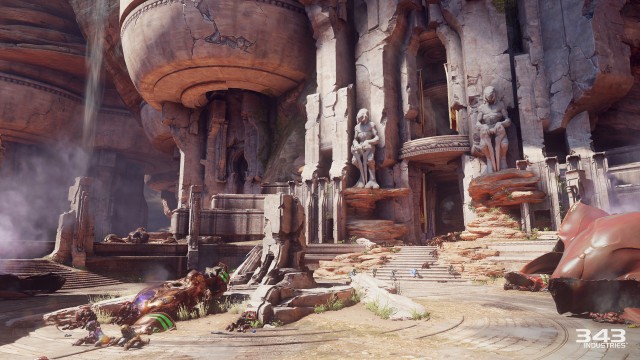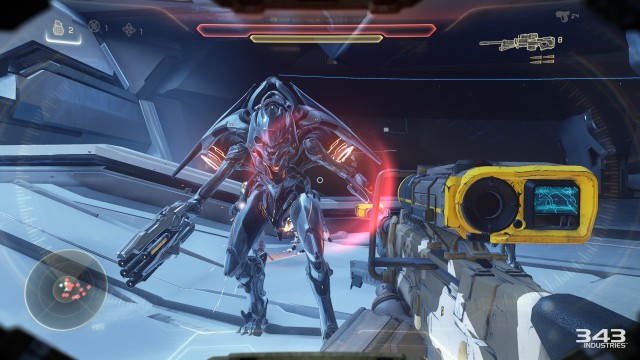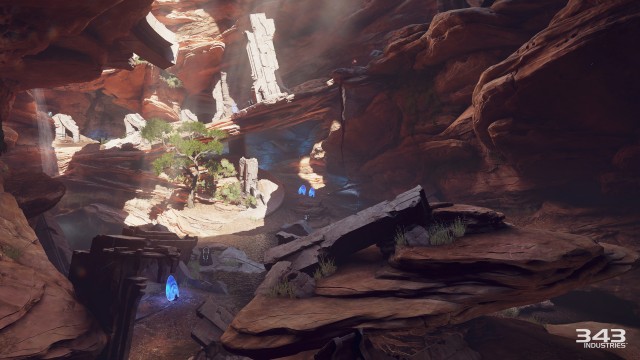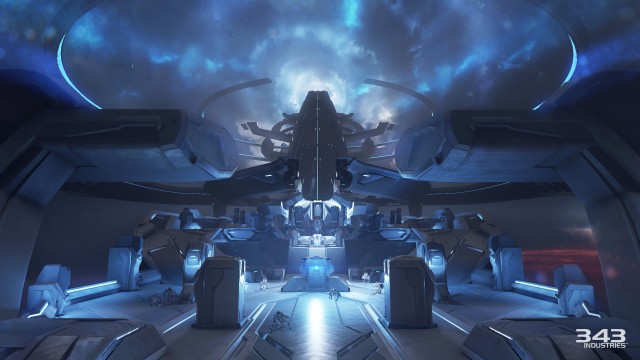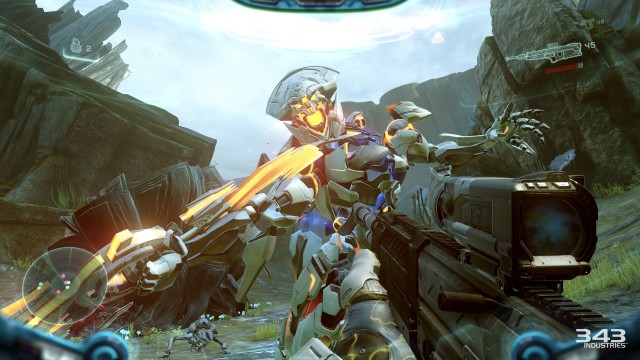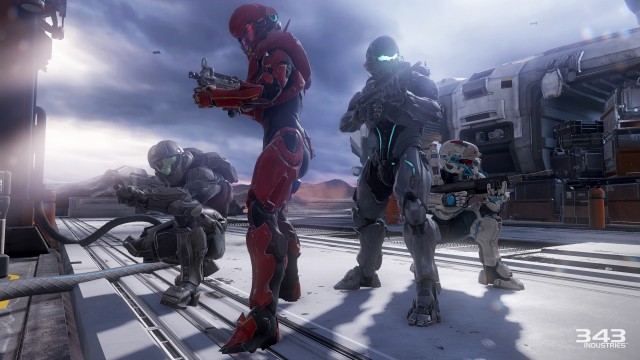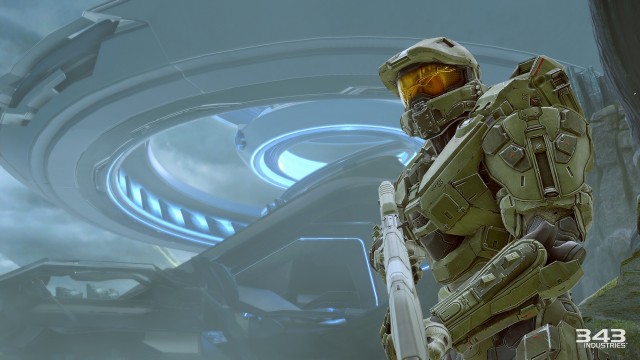Spoiler warning: mild story details follow if you have not paid attention to any preview coverage or mission walkthroughs.
When we reviewed Halo 4 three years ago (yes, it has been that long), we said that it showed huge signs of promise for 343 Industries, the then new caretakers of the Halo franchise. We hoped that that the studio would set its sights even higher and outdo themselves with the next entry in the beloved franchise. In short: they have.
The first words out of my mouth at the beginning of the first mission: “Jesus Christ.” You quite literally go from the crazy opening cinematic (you know, the one where you’re surfing on the bodies of Elites) into a free-fall down a cliffside into a pool of Covenant baddies. Which are all then obliterated by a massive blast from above.
And so is set the perfect stage for Halo 5: Guardians. This game isn’t pulling any punches.
The promise of Halo 5: Guardians was a game with a more expansive universe and a more cohesive story, all running at a blistering 60 frames per second. 343 Industries has managed to keep all of its promises from the detail of the architecture in the game’s levels to the fluidity of motion and animations, right through to the feel of the triggers on the game’s many weapons.
While we can’t say the game looks next-generational compared to Halo 4, it does look better than its predecessor, and that makes it the best looking game in the franchise so far. It is worth noting that Halo 4 was a late-generation Xbox 360 title, while Halo 5 is coming out less than two years after the Xbox One’s introduction. Imagine what late-generation Xbox One Halos could look like.
343 Industries managed to keep their buttery-smooth 60 frames per second intact by implementing resolution switching on the fly during gameplay. Most games implement flexible frame rates, whereby frames of action are dropped in order to keep a game running at 1080p. However, the team at 343 reasoned that a drop in frames is much more perceivable than a drop in resolution, so it makes much more sense to have a dynamically-adjusting resolution than it does to throw some frames away. Thus, the butter of Halo 5: Guardians.
There were perhaps one or two moments throughout the entire game that we actually noticed a stutter; perhaps a series of three or four frames dropped in sequence, and the game had a bit of a hiccup. Full disclosure: the game was running on an Xbox with the Preview Program beta dashboard installed, so anything is possible.
All that to say, Halo 5: Guardians looks freaking unbelievable. Easily the best looking game on the Xbox One so far, it has an unparalleled aesthetic that is uniquely Halo but manages to feel like something new at the same time. Some things that bothered us at the beginning of the game, such as the overly complicated HUD system on the player’s visor (and therefore all across the television screen), is a necessity in a game where so much information is being thrown at you, it almost becomes one of your combatants.
There is also some incredibly unique architecture in the game that we haven’t seen in past Halo titles. The most notable of which is easily the Elite (Sangheili) homeworld of Sanghelios. With massive stone structures and statues carved into cliff faces, it is the first time we’ve seen such intricate design from a species known for its brutality in combat.
These design choices also play into gameplay, as a new mechanic called clambering (more on that later) becomes a huge part of the way you get around, whether you’re playing as Spartan Locke or everyone’s hero, Master Chief.
Rarely, if ever, is there a piece of Guardians that looks out of place or unconsidered. Every element carries the same design language as the one before it, and everything looks complete. More importantly, it feels complete. Like these are the worlds the way they would be if they actually existed.
Perhaps one of our tiniest gripes with the visuals is that when Locke or the Chief press buttons on any sort of control panel, they kind of just punch random buttons or mash the panel haphazardly. Fine, it’s a tiny gripe, but we notice these things.
Halo has never shied away from orchestral scores, impeccable voice acting, and perfectly timed ambient music. Luckily, Guardians stays tried and true to this formula and elevates it in a few ways.
Nathan Fillion is back as Ed Buck, one of the troopers from 2009’s Halo 3: ODST. His character is now a Spartan on Fireteam Osiris, lead by Locke. Fillion is one of the most notable video game voice actors in the industry, having done voice work for Destiny, Saints Row, and following his role in ODST, he reprised his voice role as Buck in Halo: Reach.
In Guardians, Fillion returns with the charisma and humour that is needed to lighten up a serious game like Halo. His lines don’t often add much drama or move the story along at all, but he lightens the mood, something we haven’t seen in a Halo game since Sergeant Johnson.
Other audio, such as the sound of weapons fire and alien voices, is superb. Heavy weapons fire with a realistic and forceful weight about them, while lighter weapons such as the Needler have an appropriate weightlessness that correlates to their size and firepower.
Ambient music is the final note (intentional pun) that ties everything together. When Halo: Reach was released in 2010, it was clear that love and care had gone into the audio design of the game, but there were still some positions on a map that were known to trigger music, and jumping across these lines could produce jarring results. Guardians has none of that; everything seems to ebb and flow appropriately, and the music playing behind whatever the scene is, be it a massive battle or traversing the caves of Sanghelios, is all tuned well enough to be unnoticeable.
Thirty seconds of fun.
That’s the original design guideline for Halo. Create thirty seconds of fun that people really love, and stretch it out over the course of a two or eight or 20 hour game. If Halo 5 does indeed follow this formula, that thirty seconds is a hell of a lot of fun.
From the beginning of the game, there are some smaller set pieces that harken back to the very first game, Halo: Combat Evolved. It also somehow manages to feel like Halo 2 with its serious religious undertones and extensive exposition elements.
The similarities between Guardians and the games before it are more subtle in nature. The way the Assault Rifle handles, the speed (or lack thereof) which with you move, and the enemies you extinguish are all distinctly Halo. But the new elements in the game are quite possibly the best additions to the game we’ve seen since jetpacks were introduced in Halo: Reach.
Clambering is the ability to jump to the front of a ledge, then haul yourself over it to reach a new area, or just to hop on it to pop off another grunt. The new agility the Chief and other Spartans have really seems like a small addition but actually changes gameplay in a huge way.
A well-balanced trade-off between agility, flexibility, and vulnerability, it seems like every level in the game is designed with clambering in mind in at least some situations. In fact, it has instantly become one of the most convenient features in the entire game, finally making you feel like a badass soldier with a bit more flexibility than a piece of cardboard.
In addition to clambering is the ability to use your thrusters for quick boosts of agility. It comes in quite handy to get your Spartan out of a sticky situation, and also adds a new element to Halo, though one we’ve seen in part in Reach. Sprinting then tapping into the power of that thruster also allows Chief or Locke to smash their way through walls and vents, uncovering ammo caches, mission intel, and if you do it enough times, an achievement or two.
Speaking of intel, there are data pads and other collectibles littered throughout each mission. Some have more than others, but each mission carries a different style of intel. One mission has UNSC Data Pads, another has the Covenant equivalent, another has computer terminals, and so on. Each piece of intel is increasingly more difficult to find, and most of the ones we found were happenstance. In only a few situations can you look around for intel and actually find it. The rest of the time, you’ll likely be relying on a guide or sheer determination to scour every level.
The original Halo was the king of discovering new planets and worlds. Its second mission, aptly titled Halo, was akin to discovering Hyrule Field the first time in The Legend of Zelda: Ocarina of Time, or seeing the world of Grand Theft Auto: Vice City open up once you get through Starfish Island.
Unfortunately, Halo 5 only has one such moment of discovery, and its happens relatively later in the game compared to previous entries in the series. In mission eight, Swords of Sanghelios, there are massive monuments (the ones we’ve already mentioned) that really enlighten our sense of discovery within the universe. Otherwise, the locations of Halo 5 haven’t really felt like anything other than Halo. We see more militarized zones and glassed planets, but nothing that makes us want to stop and take in just exactly what marvellous land we’ve just found.
That’s pretty well the extent of our gripes with gameplay, however.
Something Halo has never quite done well is giving players options as to how to tackle firefights, and it feels like Guardians finally bucks that trend by giving players the option to go anywhere they choose and fight from any direction (and height) they want.
In one mission, the option is presented to pilot a vehicle, or hoof the route on foot, neither of which is particularly faster or slower than the other due to the nature of the terrain in front of you. It also helps that clambering is a thing. Did we mention clambering? We like clambering.
We actually chose the vehicle, if only because it was a cool new Promethean Phaeton that we hadn’t seen before, but when it was inevitably shot down, we had just as much fun traversing the terrain on foot.
One of our main gripes with Halo 4 is that the game felt very similar from mission to mission. Activate this access point, kill these enemies, activate that access point, kill these slightly more difficult enemies, rinse, repeat. This time, the only time you actually have to activate three of anything is done in such a way that you don’t realize you’ve done it until you’re told “hey, you’ve already activated the first two, go grab the last one.” Missions also vary quite drastically from one to the next. Rarely are there two missions back-to-back that have similar designs, and the gameplay varies from run-and-gun combat to Banshee flying to set piece-style boss battles frequently enough that it is impossible to expect what is coming next.
There are also very few objectives that involve any sort of sitting in one spot while waiting for waves of Covenant or Promethean enemies to try to send you to the previous checkpoint. If anything, it happened once, and it was a hell of a level. Embargos mean we can’t talk about specifics, but we’re comfortable enough telling you there’s something about a super-cool space elevator.
In fact, there are some odd objectives that seem out of place, but are adequately designed when you’re actually in-game. One such objective is, simply, “Climb the Ruins.”
343 Industries has made some interesting choices regarding the exploratory moments of Halo 5. Without letting on too much about actual storylines and missions, there are a few breather moments that slow the action down in favour of progressing the story, and they’re neither over nor underused. It shows 343’s gentle hand with new expository elements in the game, and it balances quite well with traditional gameplay mechanics.
Weapons are also more finely-tuned this time around, and those that were some of our least favourite last time around are probably some of the most satisfying on this run. The Promethean Boltshot now delivers a three-round punch with each pull of the trigger, and the rounds actually lightly hone in on their target. This makes it especially useful for taking out Crawlers and Grunts, who tend to be weak but quick enough to evade casual fire.
Other weapons are mainly tuned rather than changed in their entirety. There’s the Plasma Caster which fires mini-plasma grenades, and a redesigned Rocket Launcher. Neither of them feel quite right, though. The caster is not powerful enough, and the launcher just doesn’t feel like it has enough heft to be the successor to the classic Halo Rocket Launcher of previous games. With these two anomalies, the rest of the weapons in Guardians perform admirably, even exceptionally well.
There are plenty of nods to Halos of years past in Guardians. That Warthog run at the end of Combat Evolved and Halo 3? There’s a unique take on it which differs even from their original shortsword sequence in Halo 4. Again, we can’t give away too much, but we can say that there are some extremely creative, unique moments here that manage to also fit perfectly in the Halo universe.
And for the record: there are no Flood. Which is a good thing. Because we really hated those bastards.
The beginning of Halo 5: Guardians opens with a mission objective. As Spartan Jameson Locke, it is your duty to retrieve the Master Chief, who is absent without official leave (AWOL) from the UNSC.
You’re also on a team this time around, with Locke commanding three other Spartans (one of whom is Buck), to find the Chief. This aspect of the storyline is not overbearing; you care about your team, but they don’t ever become something that hinders gameplay or derails the story. The game is still very much about Master Chief, and 343 didn’t seem to mess with that concept too much.
Over the next few missions, you’ll switch back and forth between Locke and Chief, playing their own side of the story. We won’t tell you who wins, who loses, or if there is even a conclusion to the cat-and-mouse chase, but the story is expertly woven.
Then, the holy shit moment happens. The one where we realize we know nothing about anything and that anything could happen. The moment when we have to pause the game and replay every cinematic and moment of gameplay in our head to make sure we didn’t miss something.
It’s a moment that, understandably, will not be discussed for reasons of spoilers and embargos, but we will say this. It is a moment that holds the story of Halo 4 (and perhaps some of the Halos before it) hostage in an effort to rearrange some things in our universe.
With that said, it isn’t a complete mind-warp. It takes some new thinking to get around what happens, but if 343 Industries are master storytellers (and so far, they’ve proven to be just that), they’ll be able to convince everyone that some stories don’t end up the way we think they should. And no, we won’t be any more specific than that.
For those who play Halo for its story (and you should, even if you’re a multiplayer type), we can say that we were left quite satisfied. It’s tough to say that we wouldn’t be disappointed regardless of the ending because no one wants a good thing to end, but take solace in knowing that when Halo 4 was announced, it was done so as part of a new trilogy. So yes, there’s more to come.
There’s so much to say about Halo 5 that it could really be the best entry in the series or simply regarded as the middle entry of the second Halo trilogy. We have a feeling it won’t be either. Guardians is more than a solid attempt at a game, it is glowing proof that 343 Industries knows exactly how to continue a story and develop characters such that they grow with the people playing them.
Halo 5: Guardians is perhaps the most complete-feeling Halo since Halo 3, and while it has a couple of odd design decisions here and there, the game is a resounding success for the story it wraps up behind it, the one it unravels, and the one it begins.

